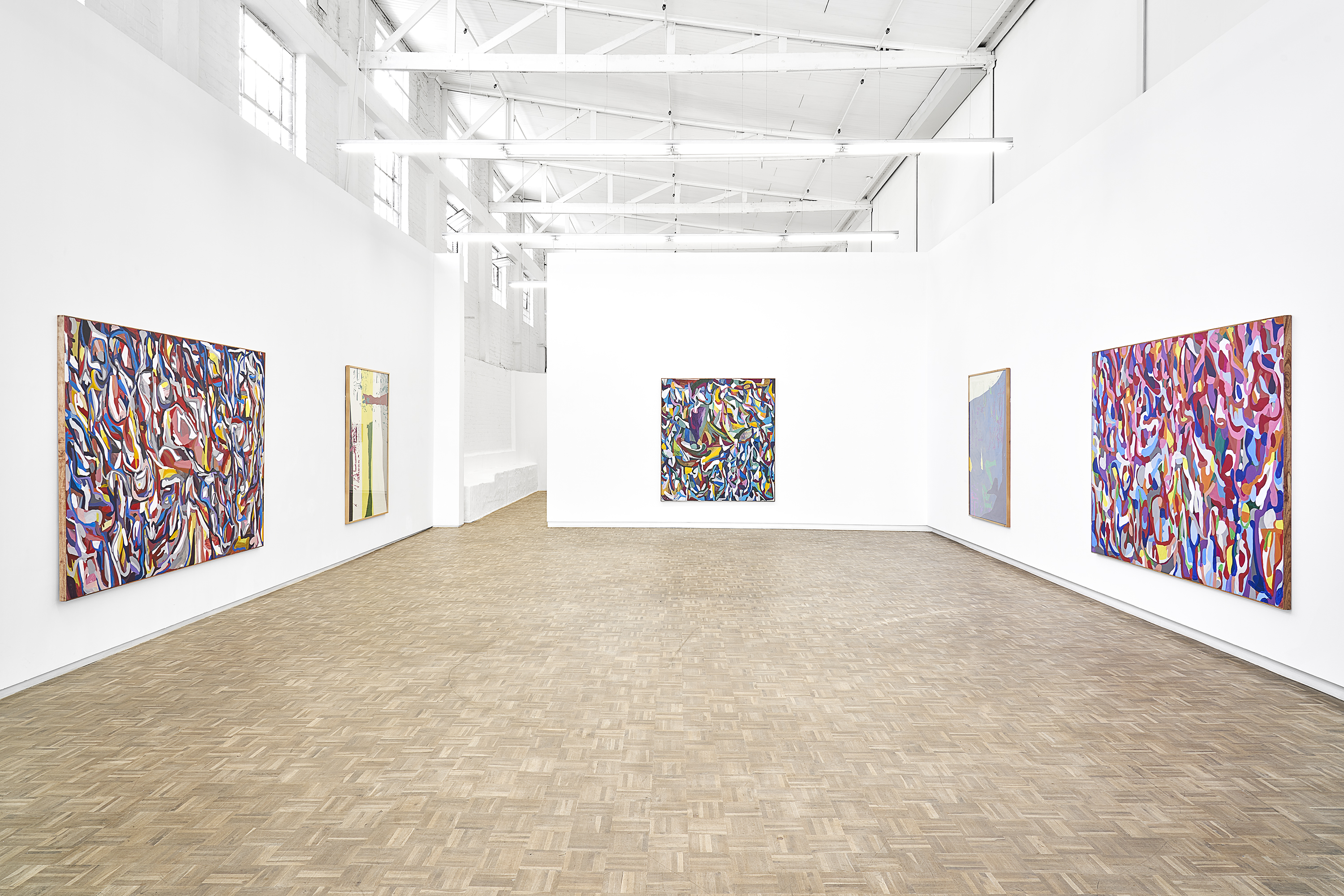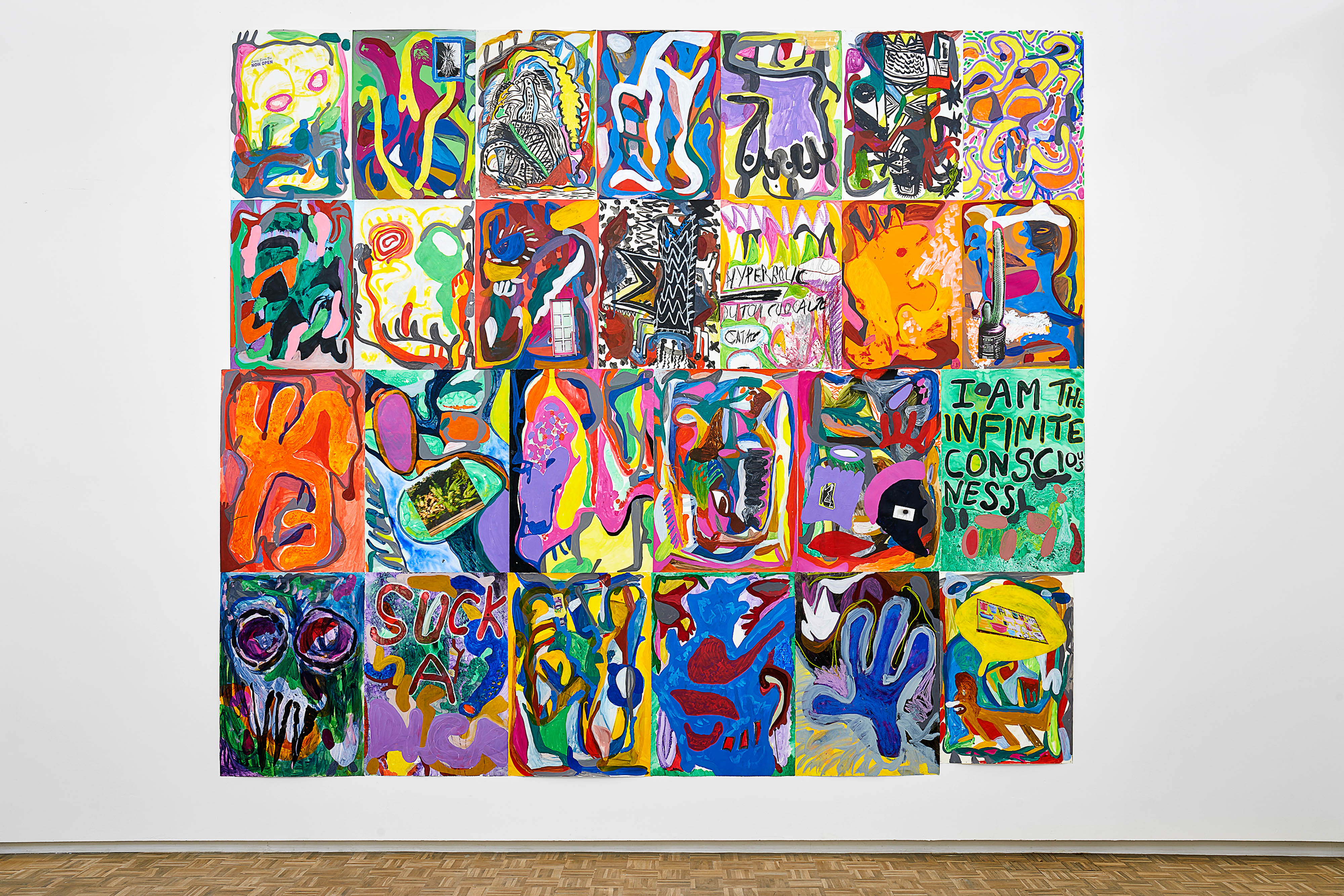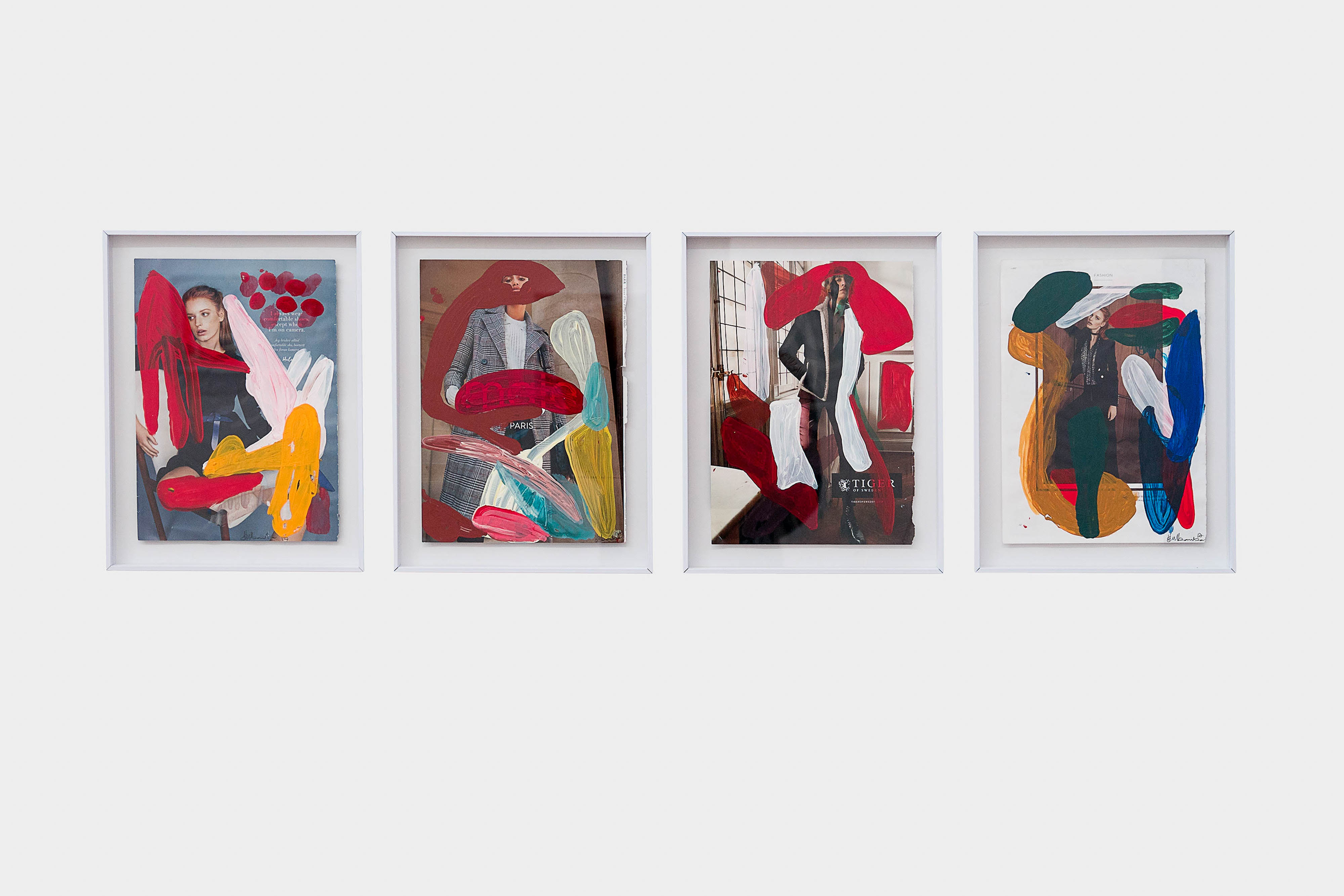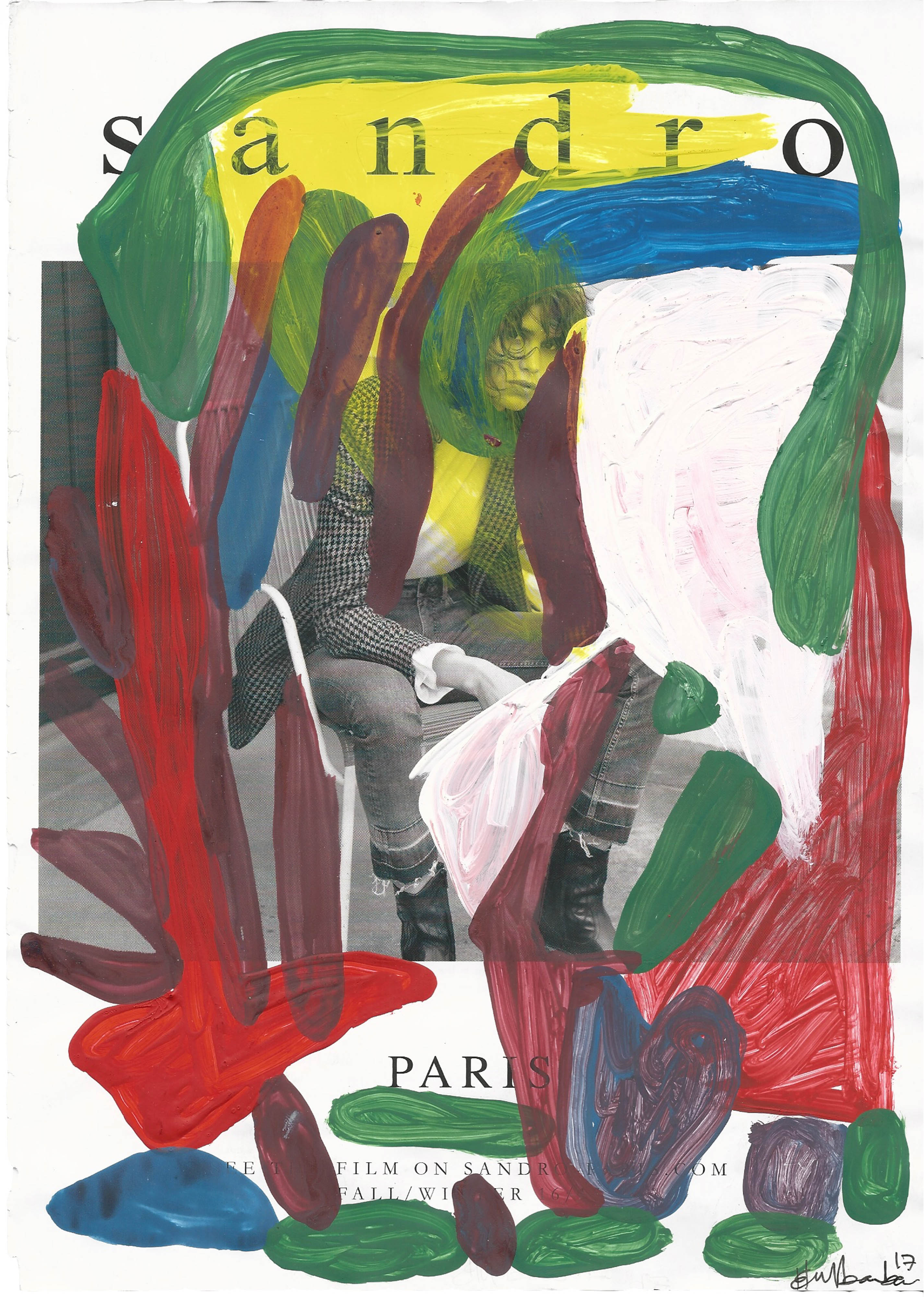












blank projects is pleased to present FR1000ID, an exhibition by Herman Mbamba and Cameron Platter. Spanning components of drawing, painting and sculpture, the exhibition draws parallels between the practices of these artists and articulates a moment in African abstraction.
The paintings of Herman Mbamba (b.1980, Gibeon, Namibia) are typified by their amorphic shapes arranged in crowded, energetic colour fields. Mbamba produces his works first as performative drawings enacted in pencil on canvas, creating composition from intersecting lines which are later filled in and exaggerated to create the artist’s recognisable vocabulary of forms. Although abstract, the visual language of the paintings is derived from earlier figurative works, comic narratives that were deconstructed and reduced over time. In these new works, however, we begin to see a return to figuration; here and there a hand, a limb, or a face emerges from an otherwise camouflage-like landscape of contrasting colour and shape.
Living in Haugesund, a city in the western reaches of Norway, and working within the expressionist vein of Lyrical Abstraction, Mbamba is acutely aware of the paradoxical nature of his practice and the conflicting expectations placed on him as a Namibian artist. For him, abstraction is a political position with which he resists the constructed role of the black diasporan artist.
Working between the mediums of drawing, sculpture, video, collage and, more recently, oil painting, Cameron Platter (b.1978, Johannesburg, South Africa) consumes, appropriates and filters the overload of information available as a waste product of the digital age. His interest in the aesthetic of trash – that is “the overlooked, subliminal, fringe elements of society” – is an exploration of those references that sit outside of “polite society’s main avenue of discourse”. Blurring the distinction between high and low culture, Platter’s eclectic and multi-disciplinary practice draws from a wide range of sources, including advertising, pornography, art history, fast food, poetry, social media, and the landscape of KwaZulu-Natal in South Africa where he is based. The works on show include new paintings, a series of large pencil-crayon drawings and two painted bronze sculptures cast from assembled polystyrene constructions.
A third and final component of the exhibition is a series of works on paper and linen made by Mbamba and Platter in collaboration. Sharing a background of working within artist collectives, their artistic exchange offered an opportunity to explore other modalities and formats, dislodging the comforts of their own practices. The collaboration also posed difficulties however, such as how to respond intuitively and respectfully to an existing painted surface and another artist’s language while preserving one’s own and without giving in to sentimentality?
Correspondence between the artists (who have never met in person) took place over several months in the form of emails, WhatsApp messages, phone calls, and artworks shipped back and forth between Norway and South Africa. Accordingly, communication was either immediate and unfiltered or slow and fragmented, and this process of working impulsively in slow motion across time and space is an essential part of the result of their collaboration.
The paintings of Herman Mbamba (b.1980, Gibeon, Namibia) are typified by their amorphic shapes arranged in crowded, energetic colour fields. Mbamba produces his works first as performative drawings enacted in pencil on canvas, creating composition from intersecting lines which are later filled in and exaggerated to create the artist’s recognisable vocabulary of forms. Although abstract, the visual language of the paintings is derived from earlier figurative works, comic narratives that were deconstructed and reduced over time. In these new works, however, we begin to see a return to figuration; here and there a hand, a limb, or a face emerges from an otherwise camouflage-like landscape of contrasting colour and shape.
Living in Haugesund, a city in the western reaches of Norway, and working within the expressionist vein of Lyrical Abstraction, Mbamba is acutely aware of the paradoxical nature of his practice and the conflicting expectations placed on him as a Namibian artist. For him, abstraction is a political position with which he resists the constructed role of the black diasporan artist.
Working between the mediums of drawing, sculpture, video, collage and, more recently, oil painting, Cameron Platter (b.1978, Johannesburg, South Africa) consumes, appropriates and filters the overload of information available as a waste product of the digital age. His interest in the aesthetic of trash – that is “the overlooked, subliminal, fringe elements of society” – is an exploration of those references that sit outside of “polite society’s main avenue of discourse”. Blurring the distinction between high and low culture, Platter’s eclectic and multi-disciplinary practice draws from a wide range of sources, including advertising, pornography, art history, fast food, poetry, social media, and the landscape of KwaZulu-Natal in South Africa where he is based. The works on show include new paintings, a series of large pencil-crayon drawings and two painted bronze sculptures cast from assembled polystyrene constructions.
A third and final component of the exhibition is a series of works on paper and linen made by Mbamba and Platter in collaboration. Sharing a background of working within artist collectives, their artistic exchange offered an opportunity to explore other modalities and formats, dislodging the comforts of their own practices. The collaboration also posed difficulties however, such as how to respond intuitively and respectfully to an existing painted surface and another artist’s language while preserving one’s own and without giving in to sentimentality?
Correspondence between the artists (who have never met in person) took place over several months in the form of emails, WhatsApp messages, phone calls, and artworks shipped back and forth between Norway and South Africa. Accordingly, communication was either immediate and unfiltered or slow and fragmented, and this process of working impulsively in slow motion across time and space is an essential part of the result of their collaboration.











╪Hâ╪Hâsa, Herman Mbamba’s first exhibition with the gallery, is comprised of a series of abstract paintings on pages torn from Norwegian fashion magazines. These paintings, while small in scale, are executed in Mbamba’s typical style with brightly coloured, amorphic shapes arranged in vivid compositions that both interact with and obliterate the imagery found on his chosen surface material. According to Mbamba, the found imagery he uses is not destroyed but rather “reorganised” through the act of appropriation. While the magazine pages in their original state are loaded with carefully contrived symbolism designed to provoke predetermined experiences in the viewer, Mbamba’s superimposed paintings shift and interrupt their meaning, creating opportunity for multiple readings and interpretations. By adding layers of paint to the glossy surface of fashion adverts in gestural brushstrokes, Mbamba enters into dialogue with the content of the advertisements, which are in his view reflective of Norway’s socio-political and cultural landscape.
The title, ╪Hâ╪Hâsa, translates from the artist’s mother tongue, Nama, to mean ‘essential’. In this body of work, Mbamba grapples with the notion of essentiality, and its relevance to him as both an artist and a diasporan. The paintings are executed in a primary visual language of colour and form, with particular shapes reoccurring like motifs throughout the series. Together with the gestural quality of Mbamba’s brush marks, the repetition of these organic forms is almost rhythmic, and they appear to be in a constant state of flux. Conceptually, the works offer a critique of the political and social spaces that construct and define identity. Specifically, Mbamba’s works are a commentary on his experience of living on the social periphery in Norway, a country considered to have one of the highest standards of living. This popular view conflicts with his own feelings of isolation and othering, and his paintings are a response to this contradiction; a mechanism with which to survive the political, social and cultural realities of Norway. For Mbamba, they are an essential means of communication in an alienating environment.
Contrasting dramatically in scale is a single, large-scale painting completed by Mbamba while on residency in Namibia. Although employing a similar formal language, the abstract mural-like work depicts a crowded harmony of light and space, inspired by the artist’s outdoor studio.
The title, ╪Hâ╪Hâsa, translates from the artist’s mother tongue, Nama, to mean ‘essential’. In this body of work, Mbamba grapples with the notion of essentiality, and its relevance to him as both an artist and a diasporan. The paintings are executed in a primary visual language of colour and form, with particular shapes reoccurring like motifs throughout the series. Together with the gestural quality of Mbamba’s brush marks, the repetition of these organic forms is almost rhythmic, and they appear to be in a constant state of flux. Conceptually, the works offer a critique of the political and social spaces that construct and define identity. Specifically, Mbamba’s works are a commentary on his experience of living on the social periphery in Norway, a country considered to have one of the highest standards of living. This popular view conflicts with his own feelings of isolation and othering, and his paintings are a response to this contradiction; a mechanism with which to survive the political, social and cultural realities of Norway. For Mbamba, they are an essential means of communication in an alienating environment.
Contrasting dramatically in scale is a single, large-scale painting completed by Mbamba while on residency in Namibia. Although employing a similar formal language, the abstract mural-like work depicts a crowded harmony of light and space, inspired by the artist’s outdoor studio.